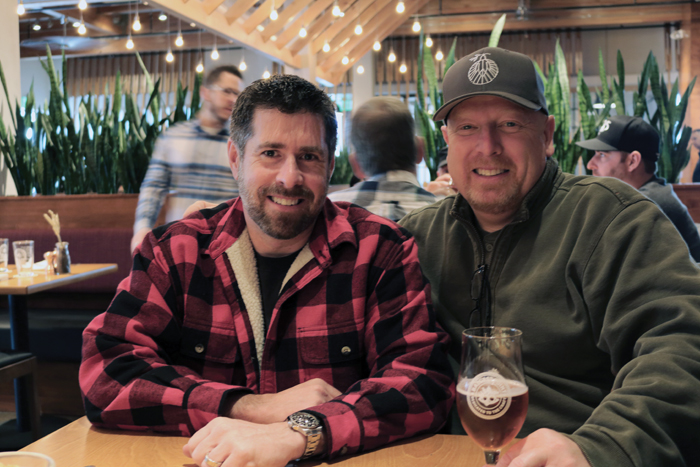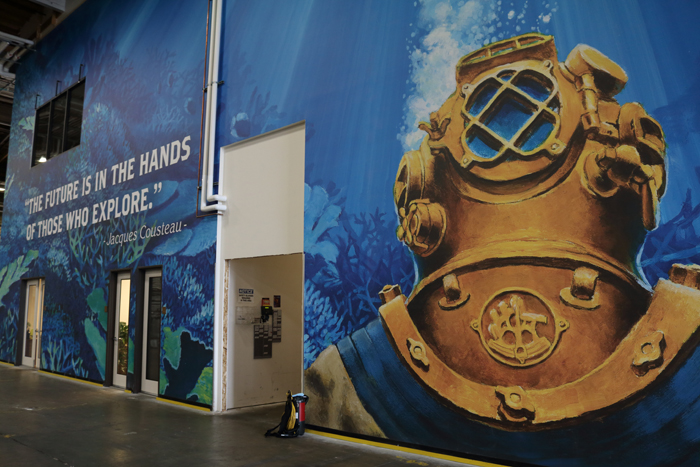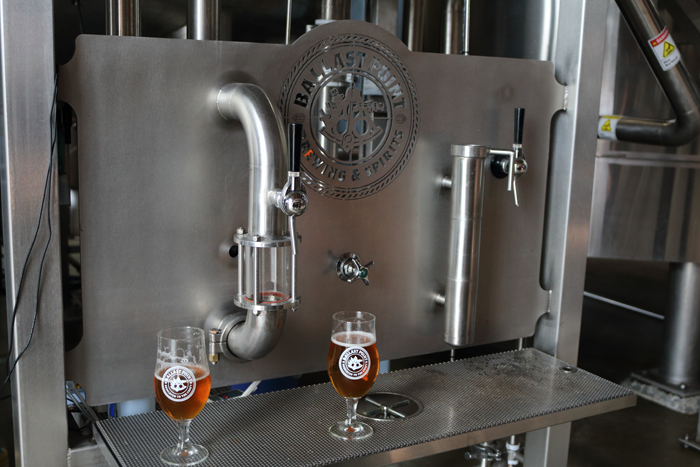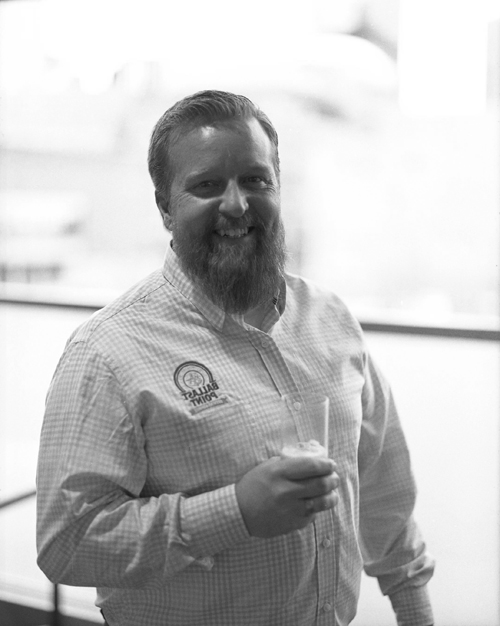Walking into Ballast Point’s new Miramar facility is a breathtaking experience. Just beyond the reception area, what amounts to San Diego’s second largest restaurant opens up like some beautiful hotel lobby. This is just the taproom, and one very small part of the whole complex. The brewery, visible through a wall of glass on one side of the restaurant, is magnificent to see, especially with its massive copper lauter tun and kettle brought from Lohr, Germany. While the physical spectacle is impressive, the fact that all of this grew from a mere homebrew shop a little more than two decades ago is even more so.
Founder/CEO Jack White was a homebrewer himself along with college roommate Peter A’Hearn. Struggling to get raw ingredients, Jack conceived the idea of opening a homebrew shop. When he launched Home Brew Mart in 1992, though, their original plans had spilled over like an unattended hombrew boil into a much crazier idea. Peter left for the University of California, Davis to get his master brewer’s certificate while Jack stayed to generate cash in the homebrew shop for an eventual brewery. They were going to go pro.
Their first employee was someone who was debating another path and whose father didn’t fully condone his decision until he earned Ballast Point one of the world’s highest brewery awards in 2010. Yuseff Cherney, now the COO and Head Brewer, recounts the story.
“I’d been buying beers from around the world with my friends. We used to drink and write down what we thought of them, more so that we wouldn’t buy them again if they were bad. I was also interested in biology and a friend of mine talked about doing homebrews. It sounded like fun. After I graduated, I had to make a decision to go to law school or do something else. That summer, I went into Home Brew Mart, which had just opened two weeks previously. I hit it off with Jack and the next day I was an employee.”
They would have to wait another four years, until 1996, before they installed their first system in the back of Home Brew Mart. Was the wait painful?
“The day-to-day work of the shop kept us busy,” says Yuseff. “And when we were done with work, we were busy homebrewing recipes so that when the brewery opened, we were ready to go. I usually had quite a lot of beer fermenting in my apartment at any given time.”
Jack commented that having a homebrew store exposed them to a talented pool of brewers to hire from over the years, and another of their early homebrewer hires was Colby Chandler, now Vice President and head of specialty brewing. He joined in 1997 as a salesclerk, taking a 70% pay cut. It apparently wasn’t a hard decision.
“To be a brewer, you have to be somewhat of a chef. I love home cooking. I think you have to be a janitor and like things to be clean. You need a little bit of a science background and I’ve always enjoyed science. I think you have to have a bit of a mechanical background as well, not only to allow you to understand the machinery, but also how to fix it. All those things drew me into brewing.”
Yuseff, Colby and their San Diego colleagues were largely responsible for developing the now-famous West Coast style of beer (which more accurately applies to Southern California). Yuseff mentions several pioneers he called on, including Skip Virgillo, who founded AleSmith, and Paul Holborn, who founded Bolt Brewing as early as 1987–perhaps San Diego’s first craft brewery.
As Yuseff explains it, “There was this core group of hop heads in the city. We all knew each other and so we would talk and share each other’s ideas and beers. Vince Marsaglia of Pizza Port was making instrumental beers. Vinnie Cilurzo of Blind Pig (now Russian River) was starting to make hoppy beers. Then Colby comes along with his IIPAs.”
This was actually a strong hoppy ale he was brewing for a homebrewers festival before there was even a IIPA style guideline. Colby seems most proud of his Sculpin IPA, one of Ballast Point’s best selling beers. In describing it, he gives one of the best explanations of West Coast style that I’ve ever heard.
“I wrote that recipe in 2005. It was a new-school, San Diego-style of brewing that looks for bright, juicy hops like Simcoe or Amarillo. You then layer that on top of a light body. My theory was always that dry-hopping adds oils to a beer. And when we are obnoxiously dry-hopping beers, that oil adds viscosity that gives a perceived body. I didn’t think you needed a lot of residual sugar from crystal malt to counter the bitterness if you already have some oily tackiness to it. Ultimately, it makes it a more drinkable product. People were dry-hopping a pound per barrel and thinking it was extreme. We use almost three pounds per barrel for Sculpin. The aromatics jump out of the glass, the beer is bright in color and flavor. It drinks like a pale ale, but is 7% and seems like an IIPA.”
On the back of Sculpin’s success, as well as several medals at the Great American Beer Festival and World Beer Cup over the previous few years, Ballast Point expanded to a second location in Scripps Ranch in 2006. Colby notes that this freed up fermenters and allowed him to experiment more.
“Back in the day, we called such experiments ‘fun beers’ but over the years it’s been good to have those beers in our portfolio. We’ve always been able to come up with new styles. It’s been an important part of keeping us relevant. That kind of homebrewing spirit that we’ve brought into the professional side is even more relevant now that we have an R&D brewery in Little Italy.”
That facility opened in 2013 after several years of enormous commercial success. Some was due to Yuseff’s foray into distilling fine spirits in 2008–Ballast Point is also San Diego’s first craft distillery. Some of the momentum was due to winning “Champion Small Brewery and Brewmaster” at the 2010 World Beer Cup.
Yuseff laughs, “It took a long time for my dad to come to grips with my not having gone to law school. It wasn’t until that award that I finally got the pat on my back.”
Even after that third brewery location, Ballast Point wasn’t finished. Just a year later, they opened the massive complex in Miramar. This was when Yuseff finally woke up and realized the utter scale of what they were doing.
“To even bring this work of art over from Germany and breathe new life into it instead of sending it to the scrap yard–it was incredible to be able to brew on it two years later. It definitely brought a tear to my eye.”
As to future directions in brewing, Yuseff reveals, “I really enjoy session beers. They have the flavor of an IPA but allow you to sit and have a few more with your friends. I think the culture is getting back to spending more time in a pub and talking to your friends. If you look at pubs in Germany or Europe in general, they are social places. To retain that, you need sessionable beers. I also think there’s room for lighter styles. When you’re out fishing and it’s hot, a light lager is nice to have. I think these will become more popular as people realize that there are craft versions of light beers. There’s a reason Germany sells millions of barrels of that kind of beer each year.”
And there’s a reason Ballast Point will continue to sell hundreds of thousands each year.
Colby asserts, “We’re making more beer now than we have in the past, but better. Between the labs and bottling lines, if we find a mistake and can’t find a creative solution, we just get rid of the product. Quality control and consistency. That’s what’s going to keep breweries around the next ten years.”
And maybe some homebrewing spirit, too, even if breweries like Ballast Point are “taking the human hand out more and more” (in Colby’s words) with larger machinery. After twenty two years, Home Brew Mart is still open, so they will have talent to draw from.
This article was published in Japan Beer Times # () and is among the limited content available online. Order your copy through our online shop or download the digital version from the iTunes store to access the full contents of this issue.









